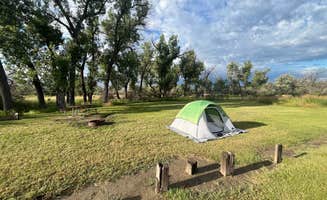Tent campsites near Miles City, Montana cluster primarily along the Yellowstone River corridor where summer temperatures frequently exceed 90°F. The area sits at approximately 2,350 feet elevation in the northern plains region, characterized by wide-open landscapes with scattered cottonwood stands. Winter camping remains limited due to seasonal closures and temperatures that routinely drop below freezing from November through March.
What to do
Fish for walleye and catfish: The Yellowstone River provides prime fishing opportunities year-round, with peak season running May through September. Far West on the Yellowstone River offers convenient river access points. "The campground does not have river access, but there are a couple sites at the fishing access point," notes Joseph W.
Visit historical sites: Miles City features several museums including the Range Riders Museum showcasing regional cowboy history, located approximately 10 miles from most camping areas. Fallon Bridge provides a convenient overnight base for history exploration. "I believe you could stay here but there are no real designated spots, it is right next to the road," explains Teresa T.
Bird watching opportunities: The river corridor serves as a significant flyway for migratory birds, particularly during spring and fall migrations. Early morning hours offer the best viewing conditions for waterfowl and shorebirds.
What campers like
River proximity: Campsites positioned along the Yellowstone River corridor provide direct water access. Bonfield receives positive reviews for its location. "This is a beautiful spot right on the river, with an upgraded boat ramp," reports Cathleen B.
Clean facilities: Despite minimal infrastructure, campers appreciate well-maintained vault toilets at select sites. "The grass was cut and the vault toilet was in good condition," mentions Joseph W. about Far West on the Yellowstone River.
Uncrowded camping experience: Most primitive camping areas near Miles City remain less frequented than sites closer to major tourist destinations. The distance from popular attractions creates opportunities for solitude, particularly at mid-week or during shoulder seasons.
What you should know
Road access challenges: Many access roads deteriorate significantly following precipitation. "The road getting in there is pretty rough, some areas of wash out ruts, so you'll need some clearance," cautions Cathleen B. regarding Diamond Motel & Campground access routes.
Limited amenities: Most tent campsites near Miles City offer only basic facilities. Sites classified as fishing access points provide even fewer services, often lacking designated campsites entirely.
Seasonal construction: Road improvements may temporarily restrict access to camping areas. "No off ramp access," reported Rick A. about Far West on the Yellowstone River during construction periods.
Tips for camping with families
Shade considerations: Summer temperatures frequently climb into the 90s, making shade essential for comfort. "One of the spots is well shaded with trees serving as a wind break. The other site is completely in the open," advises Cathleen B. about Bonfield.
Site selection timing: Arrive early to secure limited shade spots, particularly during summer weekends when temperatures exceed 85°F. Competition increases for the small number of designated sites with amenities.
Wildlife awareness: Teach children proper food storage protocols as the river corridor attracts various wildlife. Store all scented items in secure containers within vehicles when not in use.
Tips from RVers
Bridge limitations: Several access roads feature narrow bridges that restrict larger vehicles. "There is a very narrow bridge, so oversized vehicles are a no go," warns Cathleen B. about the approach to campsites.
Size restrictions: Most primitive camping areas accommodate smaller RVs better than large rigs. Consider vehicle length and clearance requirements before committing to routes with potential restrictions.
Leveling requirements: Bring leveling blocks as many sites feature uneven terrain. Most undeveloped areas lack formal parking pads, requiring careful positioning for comfort.


